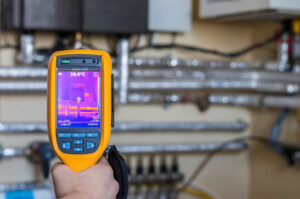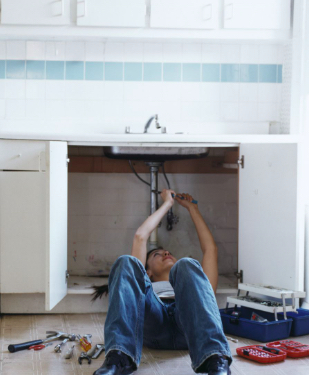Detecting leaks early can prevent costly damage and conserve valuable resources. Leak detection is a critical aspect of maintaining the integrity and efficiency of plumbing, gas, and structural systems. Whether it involves water, gas, or air, even a minor leak can lead to significant problems if left unaddressed.
The process of leak detection involves identifying and locating the source of a leak, assessing the severity of the issue, and taking appropriate steps to repair or mitigate the damage. Advanced technologies and methods have made it possible to detect leaks more accurately and efficiently, reducing the risk of long-term structural damage and increasing overall system efficiency. Contact Leak Detection San Diego for professional help.
Water leaks are among the most common issues faced by homeowners and businesses. A small, undetected water leak can waste a significant amount of water over time, leading to higher utility bills and potential structural damage. Leaks often occur in hidden areas such as walls, floors, and underground pipes, making them difficult to identify without specialized equipment. Water leaks can be caused by various factors, including aging pipes, corrosion, high water pressure, poor installation, and environmental shifts such as ground movement or temperature changes. The effects of prolonged water leaks include mold growth, wood rot, and weakened foundations, which can compromise the safety and stability of a building. Professional leak detection services use advanced tools such as acoustic sensors, infrared cameras, and moisture meters to pinpoint the exact location of a leak without causing further damage to the structure.
Gas leaks pose a serious safety hazard due to the risk of fire, explosion, and health complications from exposure to harmful fumes. Gas leaks often occur in pipelines, connectors, and appliances, where even a small crack or loose fitting can allow gas to escape. The distinct odor added to most gas supplies is intended to help identify leaks, but not all leaks are easily detected by smell alone. Exposure to gas leaks can cause symptoms such as headaches, dizziness, nausea, and respiratory issues. Prolonged exposure to certain gases can be life-threatening. Specialized gas leak detection equipment, including electronic sniffers and ultrasonic detectors, can identify leaks quickly and accurately. Immediate action is necessary when a gas leak is suspected, including shutting off the gas supply, ventilating the area, and contacting emergency services or a qualified technician to assess and repair the issue.
Air leaks, though less immediately hazardous than water or gas leaks, can lead to increased energy costs and reduced indoor comfort. Air leaks commonly occur around windows, doors, vents, and ductwork, allowing conditioned air to escape and outdoor air to enter. This forces heating and cooling systems to work harder to maintain a consistent indoor temperature, leading to higher energy consumption and utility costs. Air leaks can also introduce allergens, pollutants, and humidity into a building, affecting indoor air quality and overall comfort. Identifying air leaks often involves using thermal imaging cameras, smoke pencils, and blower door tests to measure pressure differences and pinpoint areas of leakage. Sealing air leaks with weather stripping, caulking, and insulation helps improve energy efficiency and indoor comfort.
Leak detection methods have evolved significantly with the advancement of technology. Acoustic leak detection is a widely used technique that involves listening for the sound of water, gas, or air escaping from a system. Specialized microphones and sensors detect the unique frequencies and vibrations caused by leaks, allowing technicians to identify the location and severity of the issue. Thermal imaging uses infrared cameras to detect temperature differences caused by moisture or gas leaks. This method is particularly useful for identifying leaks behind walls, under floors, and in ceilings. Tracer gas detection involves introducing a safe, non-toxic gas into a system and using sensitive detectors to locate the source of the leak based on the gas’s movement and concentration. Pressure testing involves sealing a system and pressurizing it with air or water to identify pressure drops that indicate a leak. Each of these methods has specific advantages depending on the type of leak and the structure of the system being tested.
Preventing leaks requires regular maintenance and inspection of plumbing, gas lines, and structural systems. Routine checks for signs of moisture, corrosion, and wear help identify potential issues before they become significant problems. Maintaining proper water pressure and ensuring that pipes and fixtures are securely installed reduces the risk of leaks. For gas systems, regular inspection of connectors, valves, and appliances helps prevent leaks and ensures safe operation. Sealing gaps and cracks in building envelopes with caulking and insulation reduces air leaks and improves overall energy efficiency. Professional maintenance services often include leak detection as part of their routine inspection process, providing an added layer of protection against unexpected failures.
The consequences of untreated leaks can be severe and costly. Water damage can lead to mold growth, which poses health risks and requires expensive remediation. Structural damage caused by prolonged water exposure can weaken foundations, floors, and walls, compromising the safety and integrity of a building. Gas leaks present an immediate threat to safety, with the potential for fires, explosions, and health complications. Air leaks reduce energy efficiency, increase utility costs, and contribute to poor indoor air quality. Early detection and prompt repair of leaks minimize these risks and prevent further damage.
Smart leak detection systems have become increasingly popular for residential and commercial properties. These systems use sensors and smart technology to monitor for changes in pressure, temperature, and moisture levels. When a potential leak is detected, the system sends an alert to the property owner or building manager, allowing for quick action before the issue escalates. Some smart systems are capable of automatically shutting off the water or gas supply when a leak is detected, preventing further damage and reducing the risk of catastrophic failure. The integration of smart leak detection systems with home automation platforms provides added convenience and peace of mind for property owners.
Education and awareness play an important role in effective leak detection and prevention. Property owners and tenants should be aware of the signs of leaks, including unexplained increases in utility bills, musty odors, water stains, and damp spots on walls and floors. Knowing how to shut off the water or gas supply in an emergency can prevent further damage and reduce the risk of injury. Professional leak detection services often provide educational resources and guidance to help property owners identify potential issues and respond appropriately.
Insurance coverage for leak-related damage varies depending on the type of leak and the extent of the damage. While most policies cover sudden and accidental leaks, damage caused by neglect or lack of maintenance may not be covered. Understanding the terms of an insurance policy and maintaining thorough documentation of maintenance and repairs can help streamline the claims process in the event of a leak-related incident. Some insurance providers offer discounts for installing leak detection systems, reinforcing the value of proactive leak prevention.
The future of leak detection is likely to involve continued advancements in technology and automation. Improved sensor accuracy, faster data processing, and real-time monitoring capabilities will enhance the ability to detect and respond to leaks. Machine learning and artificial intelligence are expected to play a larger role in predictive maintenance, allowing systems to identify patterns and predict potential failures before they occur. Enhanced connectivity between smart leak detection systems and building management platforms will provide greater control and efficiency in managing leaks and overall system performance.
Leak detection is a vital aspect of maintaining the safety, efficiency, and longevity of residential and commercial properties. Early identification and repair of leaks prevent costly damage, reduce utility costs, and improve overall comfort and safety. Advances in detection technology and increased awareness of leak prevention strategies have made it easier for property owners to protect their investments and maintain the integrity of their systems. By investing in professional leak detection services and adopting proactive maintenance practices, property owners can minimize the risks associated with leaks and ensure a secure and efficient environment.

